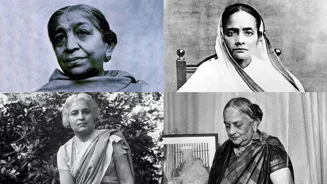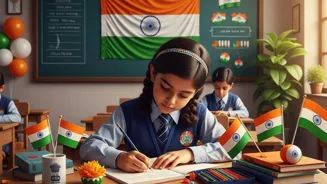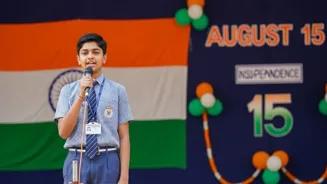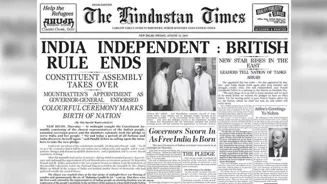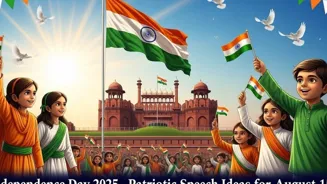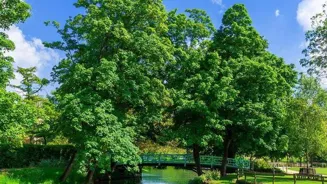History often gets told like a grand parade of kings, treaties, and decisive battles — but in the spaces between those headlines live the stories that
truly shaped a nation. Among them are the remarkable accounts of women who didn’t merely witness India’s freedom struggle, but stepped right into the storm. They were queens who refused to bow to the British, poets who stirred crowds into action, reformers who rewrote the rules of society, and strategists who outwitted the might of an empire. These were not figures who had the luxury of fighting on just one front. They battled colonial power with one hand and deep-rooted social constraints with the other. In a world that often told them their place was in the shadows, they insisted on standing in the glare of history. What follows isn’t just a roll call of heroines — it’s a journey through lives lived with astonishing courage.
Who Was the Fearless Queen Who Fought Till Her Last Breath?
Rani Lakshmi Bai
Lifespan: 19 November 1828 – 18 June 1858
Known for: Leading the 1857 Indian Rebellion
The story of Rani Lakshmi Bai reads almost like folklore — except every word of it is true. Raised in the care of her scholarly Brahmin father, she learnt to ride, wield a sword, and defend herself while other girls of her age were still confined to household lessons. Married to Raja Gangadhar Rao at just eight, she became a widow before her mid-twenties. When the British tried to annex Jhansi under the Doctrine of Lapse, she didn’t fold. In the revolt of 1857, she led her army from the front, clad in battle gear, refusing to abandon her post even after Jhansi was lost. She fought until her final breath, becoming an enduring emblem of defiance for generations to come.
Which Royal Took On the British in Awadh?
Begum Hazrat Mahal
Lifespan: 1820 – 1879
Known for: Organising resistance during the 1857 uprising in Awadh
Begum Hazrat Mahal was no figurehead — she was a strategist in silks. Wife of Nawab Wajid Ali Shah, she might have spent her days behind palace walls. Instead, when the British exiled her husband and tightened their grip on Awadh, she took charge. Rallying troops, forging alliances, and defending Lucknow, she became a pivotal figure in the 1857 rebellion. Even in exile, her spirit never dulled, and her name still commands respect as one of the few women who faced the empire head-on.
How Did Kasturba Gandhi Become a Pillar of the Satyagraha?
Kasturba Gandhi
Lifespan: 11 April 1869 – 22 February 1944
Known for: Leading women’s participation in Satyagraha
Kasturba’s life is often overshadowed by her husband’s fame, but in truth, she was the backbone of his campaigns. Married to Mohandas Gandhi at thirteen, she walked alongside him through South Africa’s struggles and India’s mass movements. She trained women in self-reliance, led protests, and braved prison sentences without hesitation. Her quiet but unshakable strength made her not just a participant, but an architect of the freedom struggle.
Who Broke Diplomatic Barriers on the Global Stage?
Vijaya Lakshmi Pandit
Lifespan: 18 August 1900 – 1 December 1990
Known for: First woman Ambassador of India and first woman President of the UN General Assembly
Born into the politically charged Nehru household, Vijaya Lakshmi Pandit inherited both privilege and responsibility. Her defiance of British authority landed her in prison more than once, but her influence extended far beyond India’s borders. Post-independence, she represented India in Moscow and later became the first woman to lead the UN General Assembly — a signal to the world that Indian women could hold the highest diplomatic ranks.
Why Was Sarojini Naidu Called the Nightingale of India?
Sarojini Naidu
Lifespan: 13 February 1879 – 2 March 1949
Known for: First woman Governor of an Indian state and celebrated poet
Sarojini Naidu’s oratory could sway a crowd as effortlessly as her poetry could stir the soul. Educated in London and Cambridge, she returned to India with a mission — to fight for women’s rights, education, and national unity. She became a prominent face in the Civil Disobedience and Quit India Movements, and after independence, served as the first woman Governor of Uttar Pradesh. Her legacy rests as much in her lyrical verses as in her political leadership.
Which Lady Became the ‘Grand Old Lady of the Independence Movement’?
Aruna Asaf Ali
Lifespan: 16 July 1909 – 29 July 1996
Known for: Hoisting the Congress flag during the Quit India Movement
In 1942, at the height of the Quit India Movement, Aruna Asaf Ali strode into history. Defying police orders, she hoisted the Congress flag at Mumbai’s Gowalia Tank Maidan, sparking protests across the country. A teacher turned activist, she endured imprisonment and constant surveillance. Post-independence, she served as Delhi’s Mayor and continued advocating for social justice well into her later years.
Who Took the Indian Flag to International Grounds?
Madam Bhikaji Cama
Lifespan: 24 September 1861 – 13 August 1936
Known for: Unfurling the Indian flag in Stuttgart, Germany in 1907
Operating largely from exile, Madam Cama became one of the most recognisable faces of India’s early independence movement abroad. At the 1907 International Socialist Conference in Stuttgart, she unfurled an early version of India’s flag, boldly introducing the cause to a global audience. Her advocacy spanned continents, calling for equality irrespective of gender, caste, or religion.
How Did Kamla Chattopadhyay Influence India’s Constitution?
Kamla Chattopadhyay
Lifespan: 3 April 1903 – 29 October 1988
Known for: Member of the Constituent Assembly and women’s rights advocate
Kamla Chattopadhyay’s political instincts were honed early, growing up in a nationalist family. Her work in the Congress party focused on increasing women’s participation in public life. As a member of the Constituent Assembly, she played an important role in ensuring gender equality found its place in India’s founding document — a legacy still shaping the nation’s laws today.
Who Was the Warrior Queen of Karnataka?
Kittur Chennamma
Lifespan: 14 November 1778 – 21 February 1829
Known for: Leading an armed rebellion in 1824 against the British
Kittur Chennamma’s defiance came decades before 1857. As ruler of Kittur, she rejected British attempts to seize her kingdom after her husband’s death. Gathering her forces, she launched an armed resistance that, though ultimately quelled, left behind a legend in Karnataka. Her name still echoes in folk songs and school lessons as the queen who dared to resist first.
Who Championed Education for Women and the Oppressed?
Savitri Bai Phule
Lifespan: 3 January 1831 – 10 March 1897
Known for: Pioneer of women’s education in India
Savitri Bai Phule was no less than a revolutionary armed with chalk and a slate. In 1848, alongside her husband Jyotirao Phule, she opened India’s first school for girls in Pune — an act that invited both ridicule and harassment. She persisted, fighting caste discrimination and ensuring education reached those long denied it. Her work laid the groundwork for modern social reform movements.
These women were more than participants in India’s fight for independence — they were catalysts. Some took up arms, others wielded the pen, the podium, or the classroom, but all of them chipped away at an empire’s power while challenging their own society’s limits. In remembering them, we remember that freedom is never a gift — it is something earned, fiercely, and at great cost.
